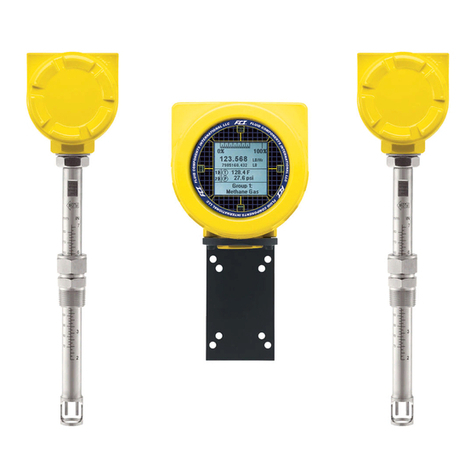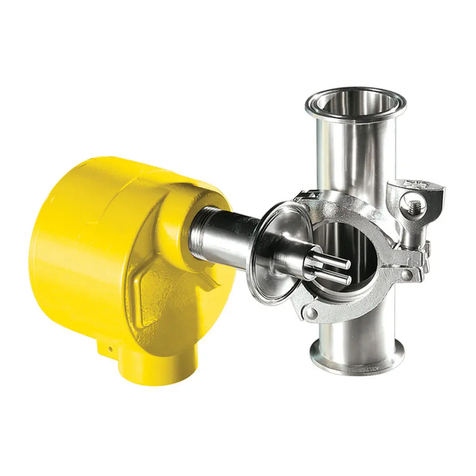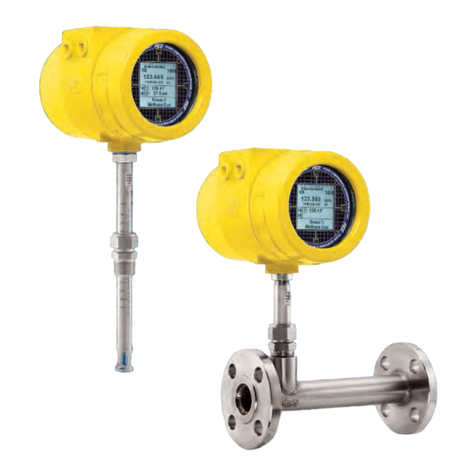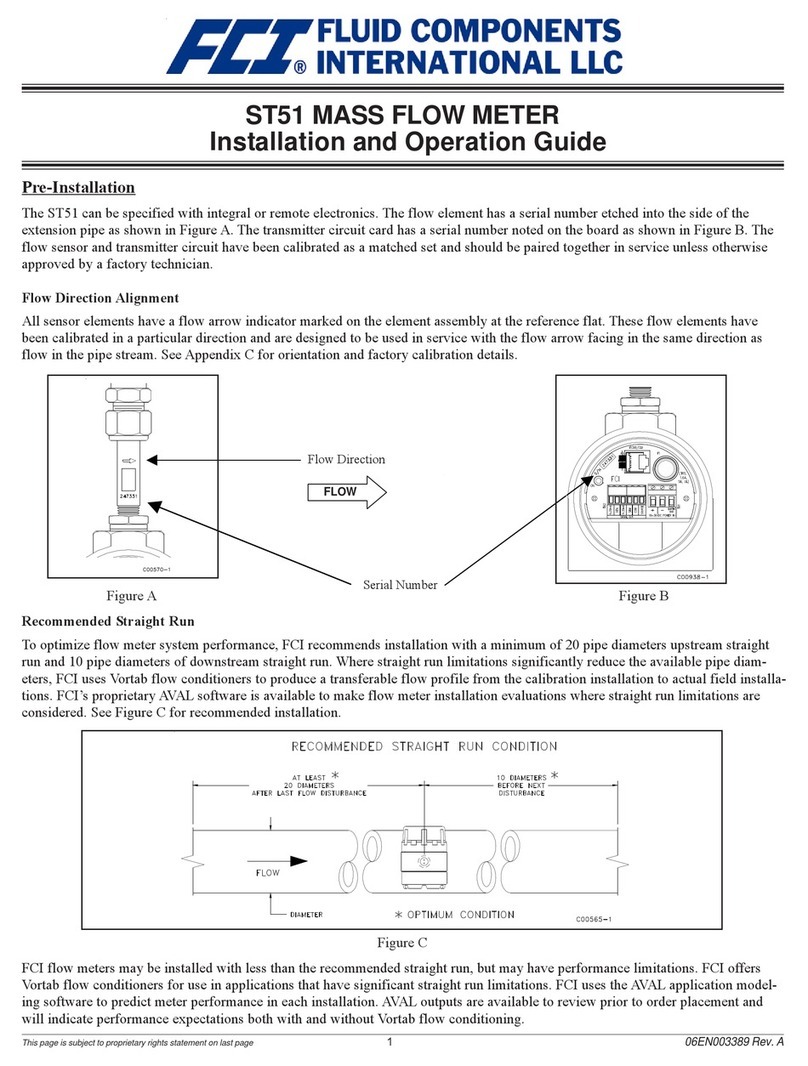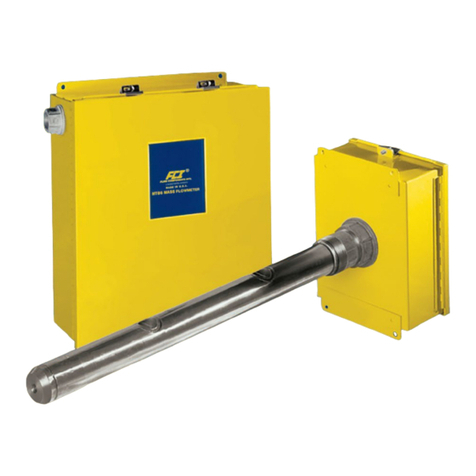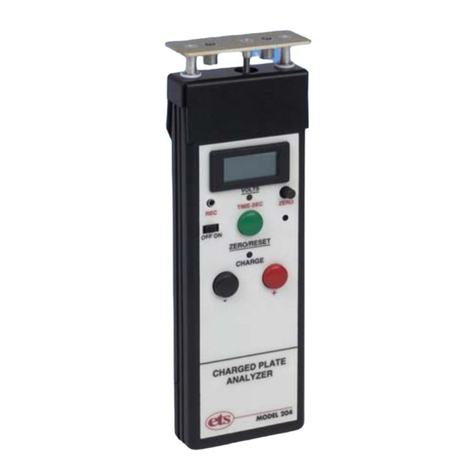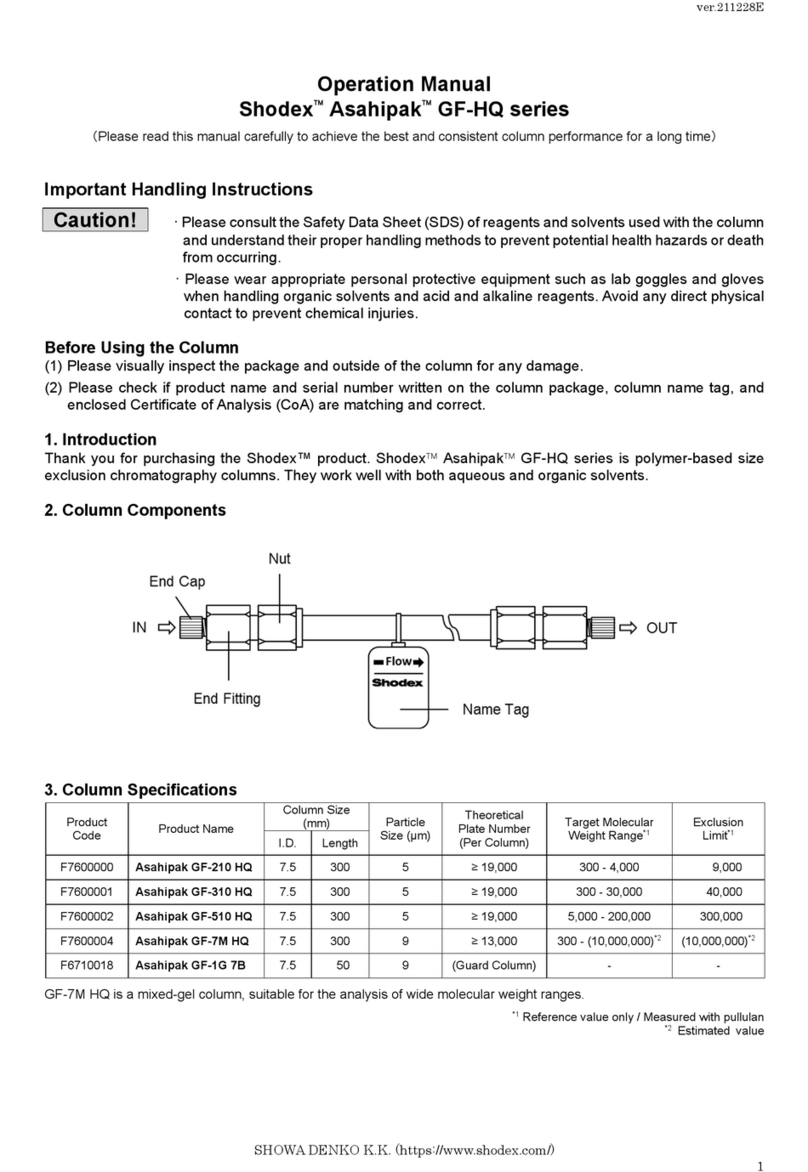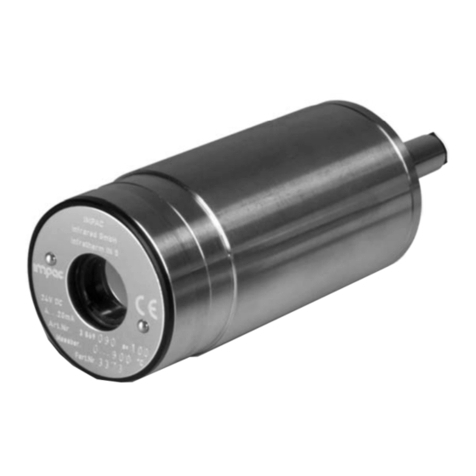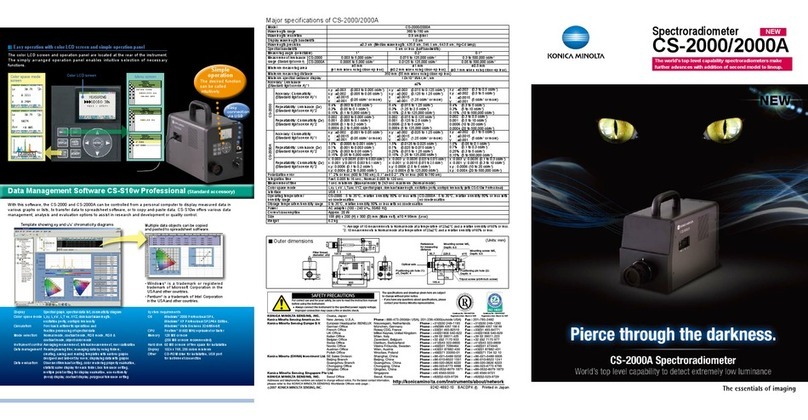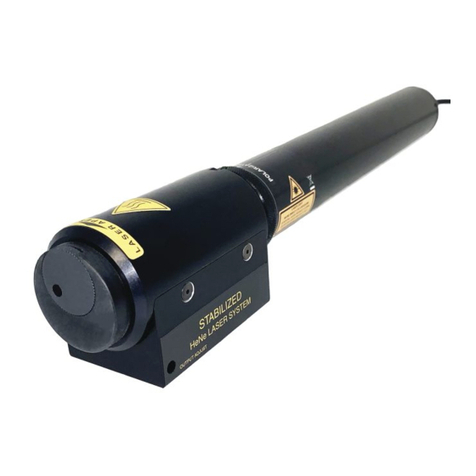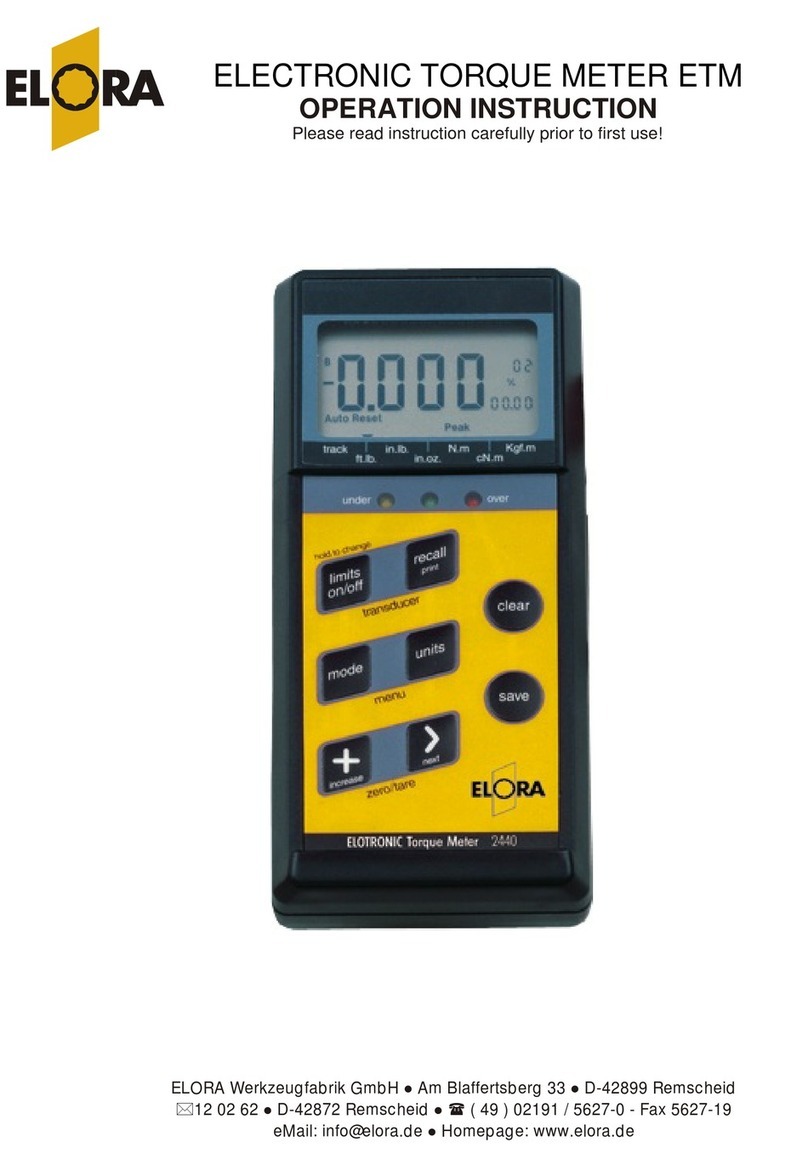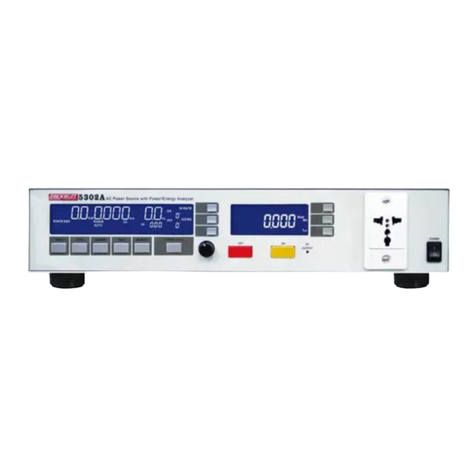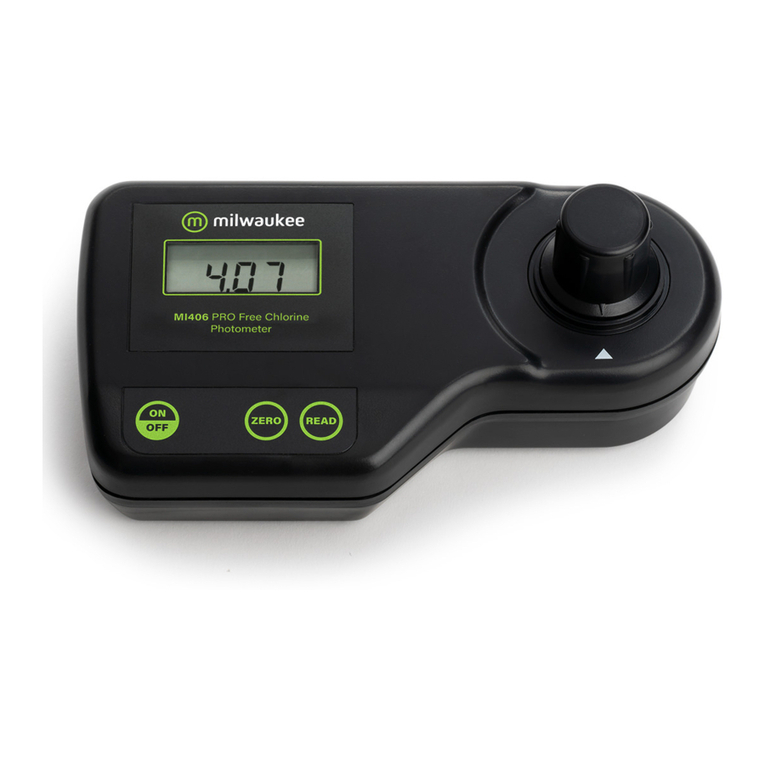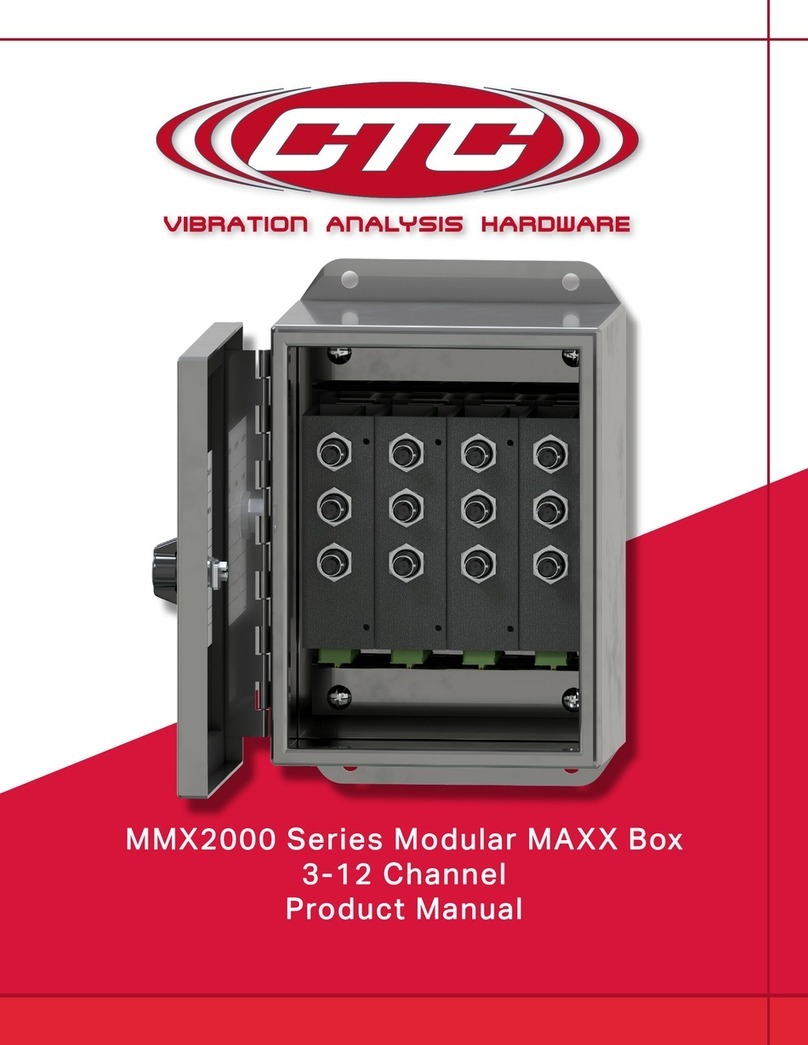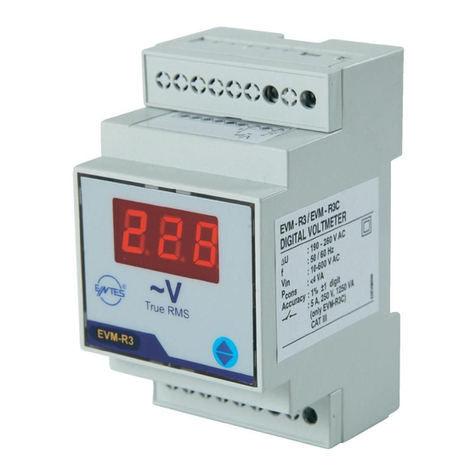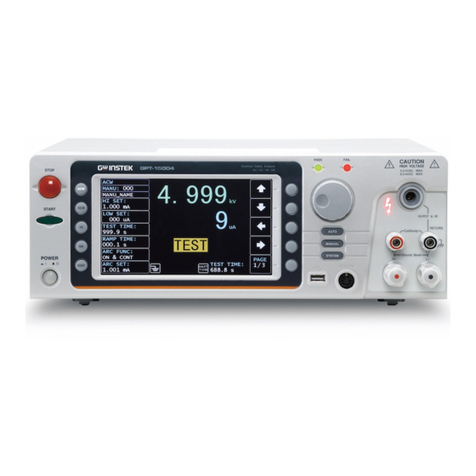FCI ST75 Operating instructions

This page is subject to proprietary rights statement on last page
1
06EN003368 Rev. G
ST75/ST75V MASS FLOW METER
Installation and Operation Guide
Pre-Installation
Serial Number Alignment
The ST75 and ST75V (Vortab) can be specied with integral or remote electronics. The ow element has a serial number etched
into the side of the HEX as shown on Figure A. In addition, the enclosure tag also shows serial and model numbers. The associated
transmitter circuit card has a serial number noted on the board as shown in Figure B. The ow sensor and transmitter circuit have been
calibrated as a matched set and should be paired together in service unless otherwise approved by a factory technician.
Flow Direction Alignment
All sensor elements have a ow arrow indicator marked on the element assembly at the reference HEX at. These ow elements have
been calibrated in a particular direction and are designed to be used in service with the ow arrow going in the same direction as ow in
the pipe stream. The ow element has been calibrated directly in the pipe tee or tube tee with careful consideration for orientation and
insertion depth. Removal from the tee section while physically possible is not recommended unless authorized by a factory technician.
Figure C - Recommended Straight Run Condition
Recommended Straight Run
To optimize ow meter system performance, FCI recommends installation with a minimum of 20 diameters upstream straight run and 10 pipe
diameters of downstream straight run. Where straight run limitations signicantly reduce the available pipe diameters, FCI uses ow conditioners
to produce a transferable ow prole from the calibration installation to actual eld installations. FCI’s proprietary AVAL software is available
to make ow meter installation evaluations where straight run limitations are considered. See Figure C for recommended installation.
Figure A Figure B
Flow Direction
Serial Number
FLOW
FLOW
247331
C00570-1
C00938-1
GND
EARTH
P3
ON
TB2
SIGNAL OUT
4-20mA
SINK
RTN
FCI
SOURCE
-
+
COM
F1
FC88/CLI
TB1
1.6A,
SB, UL)
(TR5,
18-36VDC POWER IN
247331
S/N
4-20mA
DIAMETER
AT LEAST 20 DIAMETERS
AFTER LAST FLOW DISTURBANCE
10 DIAMETERS
BEFORE NEXT
FLOW DISTURBANCE
OPTIMUM CONDITION
FLOW
C00568-3-1

Fluid Components International LLC ST75/ST75V Mass Flow Meter
This page is subject to proprietary rights statement on last page
2
06EN003368 Rev. G
Specications
Media Compatibility:
Air, compressed air, nitrogen, oxygen, argon, CO2, ozone,
other inert gases, natural gas, and other hydrocarbon gases,
hydrogen.
Pipe/Line Size Compatibility:
1/4″ to 2″ [6 mm to 51 mm]
Instrument
ST75/ST75V Range:*
* Actual range subject to gas type and specic conditions.
Accuracy:
ST75: ±2% of reading, ±0.5% of full scale
Optional: ±1% of reading, ±0.5% of full scale
ST75V: ±1% of reading, ±0.5% of full scale
Repeatability:
± 0.5% of reading
Temperature Compensation:
Standard: 40 to 100 °F [4 to 38 °C]
Optional: 0 to 250 °F [-18 to 121 °C]
Turndown Ratio: 10:1 to 100:1
Agency Approvals:
ATEX/IECEx: II 2 G Ex db IIC T6...T1 Gb
II 2 D Ex tb IIIC T85°C...T300°C Db; IP66/IP67
Ta = -40°C to +65°C
FM, FMc: Class I, Div 1, Groups B, C, D
Class I, Div 2, Groups A, B, C, D
Class II/III Div 1, Groups E, F, G
Type 4X, IP66
CRN No.: 0F0303
Warranty:
One Year
Flow Element
Installation:
ST75: In-line “T”, NPT or tube
Material of Construction:
All-welded 316 stainless steel
probe element with Hastelloy-C thermowells; 316 stainless
steel NPT and tube ttings
Maximum Operating Pressure:
ST75: T-tting [NPT female]: 240 psi [16.5 bar(g)]
Tube: 600 psi [41 bar(g)]
ST75V: 600 psi [41 bar(g)]
Temperature:
Operating: 0 to 250 °F [-18 to 121 °C]
Process Connection:
ST75: T-tting [NPT female]: 1/4″, 1/2″, 3/4″, 1″, 1 1/2″ or 2″
Tubing: 1/4″, 1/2″ or 1″
ST75V: Female NPT, Male NPT, Flange
1/4″, 1/2″, 3/4″, 1″, 1 1/2″ or 2″
Transmitter
Enclosure:
NEMA 4X [IP67], aluminum, dual conduit ports
with either 1/2″ Female NPT or M20x1.5 entries. Epoxy coated.
Output Signals:
(2) 4-20 mA user assignable to ow rate and/or temperature
(1) 0-500 Hz pulse for total ow
Communication Port:
RS232C standard.
Input Power:
DC: 18 VDC to 36 VDC (6 watts max.)
AC:
90 VAC to 264 VAC (12 watts max.; CE Mark Approval
for 100 VAC to 240 VAC)
Operating Temperature Range:
0 to 140 °F [-18 to 60 °C]
Digital Display:
(Optional)
Two-line x 16 characters LCD. Displays measured value
and engineering units. Top line assigned to ow rate. Second
line is user assignable to temperature reading, ow totalizer
or alternating. Display can be rotated in 90° increments for
optimum viewing orientation.
2"1" 1½"¾"½"¼"NPT Line Size
0.850.22 0.350.130.04Min. SCFM 1.40
[2.38][1.44][0.59][0.38][0.22][0.07]Min [NCMH]
559.27539.31139.9588.8850.6417.34Max. SCFM
[576.48] [950.20][237.78][151.00][86.04][29.47]Max. [NCMH]
1"½"¼"Tubing Line Size
0.250.050.01Min. SCFM
[0.42][0.09][0.01]Min [NCMH]
99.0821.153.02Max. SCFM
Max. [NCMH] [5.14] [35.94] [168.33]

ST75/ST75V Mass Flow Meter Fluid Components International LLC
This page is subject to proprietary rights statement on last page
3
06EN003368 Rev. G
FCI ow meters may be installed with less than the recommended straight run, but at the risk of limiting performance. FCI offers
VORTAB ow conditioners for use in applications that have signicant straight run limitations. FCI uses the AVAL application model-
ing software to predict meter performance in each installation. AVAL outputs are available to review prior to order placement and will
indicate performance expectations both with and without ow conditioning.
Flow Element Installation
Caution: The element is shipped installed in the tee, with the element specically oriented for inline installation. Do not
remove the sensing element from the tee section during installation as calibration can be adversely affected.
Process Connections
The ST75 is available in pipe tee congurations with NPT threads and tubing tees with a compression tting suitable to clamp down
on concentric smooth surface tubing. The pipe tee versions are standard 150# class rated tees suitable for service up to 150 PSIG at the
process temperature maximum of 250 °F (121 °C). The compression tting material offered in the tube type conguration is rated for
250 PSIG service.
Pipe Tee Installation: With pipe extensions properly cut to length and the appropriate sealing materials used on the threads, install ow
element section by slowly rotating the conguration until rmly secure on the pipe section. Complete by installing opposing end pipe
section using care to rmly secure the element assembly either in a top mount or side mount position.
Tube Tee Installation: Clean all mating surfaces of the tee tting, ferrules and the ow tube. Insert the ow tubing into the tee tting.
Make sure the tubing rests rmly in the tting counter bore seat. Tighten the nut on both ends of the tee by hand. Hold the tting body
steady with a backup wrench, tighten the tting nuts 1-1/4 turns, from hand tight baseline.
The ST75V is available in with ow tube congurations offering male and female NPT threads, ANSI anges and DIN anges. The ow
tube assemblies are rated for service up to 240 PSIG at the process temperature maximum of 250 °F (121 °C).
NPT Flow Tube Installation: With pipe extensions properly cut to length and the appropriate sealing materials used on the threads, install
ow element section by slowly rotating the conguration until rmly secure on the pipe section. Complete by installing opposing end
pipe section using care to rmly secure the element assembly either in a top mount or side mount position.
Flanged Installation: Clean all mating surfaces. Install appropriate sealing gasket between mating anges. Tighten ange mating hardware
to meet system sealing requiments.
See Appendix C for instrument outline dimensional details.

Fluid Components International LLC ST75/ST75V Mass Flow Meter
This page is subject to proprietary rights statement on last page
4
06EN003368 Rev. G
Instrument Wiring
Before opening the instrument to connect power and signal observe the following ESD precautions:
Use a wrist band or heel strap with a 1 megohm resistor connected to ground. If the instrument is in the shop setting, use a static
conductive mat on the work table or oor with a 1 megohm resistor connected to ground. Connect the instrument to ground. Apply
antistatic agents such as Static Free made by Chemtronics (or equivalent) to hand tools to be used on the instrument. Keep high static
producing items away from the instrument.
The above precautions are minimum requirements. The complete use of ESD precautions can be found in the U.S. Dept. of Defense
Handbook 263.
Warning: Only qualied personnel are to wire or test this instrument. The operator assumes all responsibility for safe
practices while wiring and trouble shooting.
Install an input power disconnect switch and fuse near the instrument to interrupt power during installation and maintenance.
Operator must have power disconnected before wiring.
See the “Specic Conditions of Use” and “Safety Instructions” sections in Appendix A for use of the ST75/ST75V (AC and
DC versions) in Hazardous Areas Category II (Zone 1).
Input Power
The ST75/ST75V is available with both VDC and VAC input power congurations. Customers selecting VDC input power will have a
VDC input board only. Similarly, the VAC power board is supplied only with VAC powered units. In addition, both boards are marked
for either AC or DC power. Only connect the power specied on the wiring module as shown on Figures D and E respectively. Both
VAC and VDC inputs require a Gnd wire to be connected. Input power terminal blocks accept 14-26 AWG wire.
Make sure that power is OFF before wiring the instrument. Pull the power and signal output wires through the port, using care not to
damage wires. FCI recommends using crimp lugs on the output wires to ensure proper connection with the terminal strip. Connect the
output wires as shown on Figures D and E. Note that when the 4-20 mA outputs are used simultaneously, a single return lead is used.
Analog Output
4-20 mA: The instrument is provided with two 4-20 mA outputs. By default Output 1 is congured for ow and Output 2 is congured
for temperature. Terminal blocks accept 14-28 AWG wire, 500 ohms max load per output.

ST75/ST75V Mass Flow Meter Fluid Components International LLC
This page is subject to proprietary rights statement on last page
5
06EN003368 Rev. G
Pulse Output Activation
The ST75/ST75V provides a pulse output feature. Instruments ordered with volumetric or mass ow units are factory set with totalizer
and pulse output activated. The mode can be changed in the eld. Source and sink output wiring is shown in Figures D and E below.
Though only one conguration is shown with the VAC and VDC power supplies, the source or sink can be used with either power input.
Sink Mode: 40 VDC max., 150 mA max. Customer-supplied power source.
Source Mode: 15 VDC output, 50 mA max.
Figure D
VDC Power Connection
Figure E
VAC Power Connection
VAC Power
As Shown:
85-265 VAC power connected with Gnd
4-20 mA connected for ow and temperature
Pulse Out in sink mode
Note: In sink mode, 40 VDC max., 150 mA max. customer-
supplied power source.
Power Dissipation
AC Version
Power dissipation values under nominal conditions:
Instrument (Electronics + Sensor): 11.6 watts
Sensor only: 0.25 watts
Power dissipation values under maximum load conditions:
Instrument (Electronics + Sensor): 12 watts
Sensor only: 0.30 watts
DC Version
Power dissipation values under nominal conditions:
Instrument (Electronics + Sensor): 4.5 watts
Sensor only: 0.25 watts
Power dissipation values under maximum load conditions:
Instrument (Electronics + Sensor): 6 watts
Sensor only: 0.30 watts
VDC Power
As Shown:
18-36 VDC power connected with Gnd
4-20 mA connected for ow and temperature
Pulse Out in source mode
Note: In source mode, 15 VDC output max., 50 mA max.
(TR5,
ON
TB2
+
18-36VDC POWER IN
SOURCE
SINK
4-20mA
I OUT 1
COM
I OUT 2
4-20mA
RTN
SIGNAL OUT
FCI
-EARTH
GND
TB1
1.6A,
SB, UL)
S/N
FC88/CLI
P3 F1
C01440-1-1
RS-232
Connection
Source
Output Counter Input
DC POWER IN4-20 mA OUTS
IN
COM
10 KΩ
C01441-1-1
(TR5, 250V
F1
1.6A, SB, UL)
TB1
4-20mA
SOURCE
OUT
ANALOG
TB2
4-20mA
RTN
OUT
PULSE
ON
TB3
SINK
COM
NEUT
AC
85-265VAC
LINE
AC
POWER IN
GND
EARTH
P3
FC88/CLI FCI
S/N
RS-232
Connection
Ext. 24-40 VDC
Power Supply
150 mA Max.
Counter Input
IN
COM
10 KΩ
–+
AC POWER IN4-20 mA OUTS
Sink
Output

Fluid Components International LLC ST75/ST75V Mass Flow Meter
This page is subject to proprietary rights statement on last page
6
06EN003368 Rev. G
Setup Interface
All parameters on this meter are set through the RS232 interface connection (P3 plug). The RS232 interface allows the instrument to
be set up with either an FC88 hand held communicator or a computer. The FC88 is powered through the meter and comes with the
serial interface cable. If a computer interface is used, an adapter (RJ to 9-pin PC serial port) is required. The adapter can be obtained
from FCI: Part No. 014108-02.
Using a serial comm/terminal program (e.g., HyperTerminal, TeraTerm, Putty, etc.) congure the PC’s serial port (the one intended to
be connected to the instrument) as listed in the table below.
COM Port Number: Number of COM port connected to instrument (COM1, COM2, etc.)
Baud Rate: 9600
Number of Bits: 8
Stop Bits: 1
Parity: None
Flow Control: None
Terminal Emulation: VT100
After conguring the serial port (and making the PC-to-instrument connections) start a communications session with the applicable se-
rial port. Enter any of the meter’s single letter commands in the program’s terminal window to execute a function. See “Table 5. ST75/
ST75V List of Single Letter Commands” on page 23 (Appendix B) for the complete command list.
An additional command line interface (CLI) is available through the RS232 port. This interface is accessed with the “Y” command
using a computer or FC88. The command line password is “357”. See “Table 6. ST75/ST75V List of CLI Commands” on page 23
(Appendix B) for command line details.

ST75/ST75V Mass Flow Meter Fluid Components International LLC
This page is subject to proprietary rights statement on last page
7
06EN003368 Rev. G
Start-up and Commissioning
1. Verify all input power and output signal wiring is correct and ready for initial power start-up.
2. Apply power to the instrument. The instrument initializes in the Normal Operation Mode with all outputs active. An instrument
with the display option indicates ow with the factory-set ow units. Allow 10 minutes for the instrument to warm up and reach
thermal equilibrium.
The following FC88 commands are typical commands that are used during start-up and commissioning:
Ent
e
r
Dis
pla
yDesc
r
i
pt
io
n
Enter menu: > From Normal Operation Mode
ZE for English M for Metric > Flow Unit Set-Up menu
E0=SFPS, 1=SCFM, 2=SCFH, 3=LB/H,
4=GPM #
English units
1R round duct or S rectangular> Select standard cubic ft./minute (SCFM)
RDia.: 4.0260000
Change? (Y/N)>
Select Round Duct
YEnter value: #
3.068 area: 7.3926572 CMinow: 0.0000000
Change? (Y/N)>
3 inch Sch. 40 pipe I.D.
NMaximum ow: 462.04
Enter to continue
YCmaxow: 462.04
Change? (Y/N)>
Y#
462.04 CMintemp (F): -40.00000
Change? (Y/N)>
NCMaxtemp (F): 250.00000
Change? (Y/N)>
NPercent of Range is: OFF
Change to ON?>
NLCD Mult Factor x1
Change? (Y/N)>
N100.0 SCFM Instrument ends up in Normal Operation Mode
Command Name Description
TNormal Operation Mode All outputs are active
Z Flow Unit Set-up Select Flow Units (4 English, 4 Metric) Pipe Di-
mensions
W Totalizer Enable/Disable
VOutput Conguration Select one of 4 Congurations: Pulse and/or Alarm-
Pulse factor and/or setpoint
F K-Factor (default = 1) Flow factor
N Warm Reset Re-initialize C/B
STotalizer Menu Enables W menu (Option)
When placed in service, the instrument indicates 0.000 for no process ow.
Flow Unit Modication
Example: SCFM Flow Units and 3 inch Sch 40 round pipe size set up:

Fluid Components International LLC ST75/ST75V Mass Flow Meter
This page is subject to proprietary rights statement on last page
8
06EN003368 Rev. G
RS232 / FC88
Menu Control and Organization
Most entries require at least two keystrokes; a capital letter and the [ENTER] key, or one or more numbers and the [ENTER] key. All
user entries begin at the input mode prompt “>”, except when the instrument is in the Main Function Mode (just press the desired
function letter and [ENTER] to make an entry).
Backspaces are made using the backspace [BKSP] key. Some entries are case sensitive between numbers and letters. Be sure the
SHIFT key is pressed to indicate the correct case. A square after the prompt caret indicates the FC88 is in lower case. A slightly raised
rectangle in the same spot indicates the FC88 is in the upper case.
It is recommended that the FC88 be plugged into the instrument before power is applied. If the FC88 is plugged in while the
instrument power is on and the FC88 does not respond, press [ENTER]. If there is still no response press [N] or cycle the power.
Note: The Zero and Span may be changed from the original calibration, provided the new values are within the original
calibrated range; i.e., if the original calibration was 1 to 100 SCFM (4-20 mA), the new zero (4 mA) must be equal to or
greater than 1 SCFM, and the new span (20 mA) must be equal to or less than 100 SCFM.
Some entries require a Factory pass code. If this occurs contact FCI Field Service to continue programming the instrument. The
instrument will prompt the user when this is necessary. Do not change any parameters that require this code unless there is an absolute
understanding of the instrument’s operation. The user cannot exit some routines unless all entries are completed or the power is cycled.
The top level of the menu is shown in “Table 5. ST75/ST75V List of Single Letter Commands” on page 23. Enter the command
letter mnemonic as listed in the tables below and in Appendix B to run a command. Exit a command at any time by entering “Q”
[ENTER] in the menus D, K, V, W, or Z.
Units
Select E=English M=Metric
Select 0= SFPS 5 = SMPS
or 1 = SCFM 6 = NCMH
or 2 = SCFH 7 = NCMM
or 3 = LBS/H 8 = KG/H
or 4 = GPM 9 = LPM
or 10 = SCMH
or 11 = NMPS
or 12 = SCMM
For Volumetric or Mass Flow
Select R = Round pipe or duct
or S = Square duct
Set Diameter or Wide X High (in inches or mm)
Set CMaxow = Maximum ow rate (span)
Set CMinow = Minimum ow rate (zero)
Table 2. Z Menu – Units and Scaling Setup
Note: Changing units requires rescaling the unit (set new zero and span).
Table 1. Diagnostics and Factory Settings
C Calibration Information
Display only: A/D, Delta-R, Ref-R data values
D Diagnostics
Display only: List of unit parameters.
K Factory Calibration Settings
Display only: Cal. parameters; i.e., linearization
and temperature compensation coefcients.
R Factory Reset
Replaces user data with factory calibration data.
Select
4-20 mA Output
Conguration
Select
1
4-20 mA Output #1 = Flow
4-20 mA Output #2 = Temp
2
4-20 mA Output #1 = Flow
4-20 mA Output #2 = Flow
3
4-20 mA Output #1 = Temp
4-20 mA Output #2 = Flow
4
4-20 mA Output #1 = Temp
4-20 mA Output #2 = Temp
Select
NAMUR Mode Select 1
NAMUR: OFF
2
NAMUR: Low
3
NAMUR: High
Select
Source/Sink
(Pulse) Output
Conguration
Select
1
Source = Pulse
Sink = Pulse
2
Source = Pulse
Sink = Alarm1
3
Source = Alarm0
Sink = Pulse
4
Source = Alarm0
Sink = Alarm1
Set PFactor PFactor PFactor Switchpoint0
Set Sample Period Sample Period Sample Period Source state
Set Source state Source state Switchpoint0 Switchpoint1
Set Sink state Switchpoint1 Source state Sink state
Set n/a Sink state Sink state n/a
Table 3. V Menu – Output Conguration Setup

ST75/ST75V Mass Flow Meter Fluid Components International LLC
This page is subject to proprietary rights statement on last page
9
06EN003368 Rev. G
Example: COMMAND V (Reference Table 3)
Case: 4-20 mA #1 = Flow, 4-20 mA #2 = Temperature, NAMUR = Low, Source Out = Pulse, Sink = Alarm1
Pressing [V] [ENTER] will display “Output Mode Selected”
The last saved mode of the next menu item displays:
“4-20 mA #1 = Flow” “ 4-20 mA #2 = Temp” ...followed by the prompt:
“Change? (Y/N)”
Press [ENTER] (no change).
The last saved mode of the next menu item displays:
“NAMUR: Off” ...followed by the prompt:
“Change? (Y/N)” Select Y [Enter]. The display reads,
“NAMUR: Off” ...followed by the prompt:
“Enter 1 to make the selection #.” Select [ENTER]. Bypassing “1” the next display reads,
“NAMUR: Low” ...followed by the prompt:
“Enter 2 to make the selection #.” Select 2 and [ENTER]. “2” sets the new NAMUR conguration.
The last saved mode of the next menu item displays:
“Source: Pulse” “Sink: Pulse” ...followed by the prompt:
“Change? (Y/N)” Select Y [Enter]. The display reads,
“Source: Pulse” “Sink: Pulse” ...followed by the prompt:
“Enter 1 to make the selection #.” Select [ENTER]. Bypassing “1” the next display reads,
“Source: Pulse” “Sink: Alarm1” ...followed by the prompt:
“Enter 2 to make the selection #.” Select 2 and [ENTER]. “2” sets the new source/sink conguration.
The last saved mode of the next menu item displays:
“PFactor: 1.000” ...followed by the prompt:
“Change? (Y/N)>” Respond with “Y” to enter a factor anywhere from
0.001 to 1000. A pulse factor of 1.000 outputs 1
pulse per unit of ow. If no change, select N and/or
[ENTER] to continue.
“V” Menu Output Conguration Setup
Use the V menu to set up the 4-20 mA analog outputs (including NAMUR conguration) and source/sink (pulse) outputs.
Note:The display comes up to the last setting saved and stays for 2 seconds. If N or [ENTER] is entered, the menu proceeds to
the next item in the sequence (refer to “Table 3. V Menu – Output Conguration Setup” on page 8). If Y is entered, the display
moves to the selection options and/or asks for conrmation. If you miss the option, select [Enter] repeatedly to loop around.
Analog Out
Output Mode Selected
4-20 mA #1: Flow
4-20 mA #2: Temp
Change? (Y/N)>
4-20 mA #1: Flow
4-20 mA #2: Temp
Enter 1 to make
the selection__
4-20 mA #1: Flow
4-20 mA #2: Flow
Enter 2 to make
the selection__
4-20 mA #1: Temp
4-20 mA #2: Flow
Enter 3 to make
the selection__
4-20 mA #1: Temp
4-20 mA #2: Temp
Enter 4 to make
the selection__
NAMUR Mode Selected
NAMUR: Off
Change? (Y/N)>
NAMUR: Off
Enter 1 to make
the selection #__
NAMUR: Low
Enter 2 to make
the selection #__
NAMUR: High
Enter 3 to make
the selection #__
Pulse Out
Pulse Out Selected
Source: Pulse
Sink: Pulse
Change? (Y/N)>
Source: Pulse
Sink: Pulse
Enter 1 to make
the selection #__
Source: Pulse
Sink: Alarm1
Enter 2 to make
the selection #__
Source: Alarm0
Sink: Pulse
Enter 3 to make
the selection #__
Source: Alarm0
Sink: Alarm1
Enter 4 to make
the selection #__
PFactor: 1.000
Change? (Y/N)>
if yes
Enter new factor: ____
Sample Period: 1 second
Change? (Y/N)>
if yes
Enter new Sample Period: ____
If alarm is a selected output
Set point1: 000 Set points are in the
same units as the flow
or temp.
Change? (Y/N)>
if yes
Enter new set point: ____
Resume normal operation
Source state:
High to Low
Change to Low to High?>

Fluid Components International LLC ST75/ST75V Mass Flow Meter
This page is subject to proprietary rights statement on last page
10
06EN003368 Rev. G
The FCI instrument requires little maintenance. There are no moving parts or mechanical parts subject to wear in the instrument. The
sensor assembly, which is exposed to the process media, is composed of 316 SS and Hastelloy C.
Without detailed knowledge of the environmental parameters of the application surroundings and process media, FCI cannot make
specic recommendations for periodic inspection, cleaning, or testing procedures. However, some suggested general guidelines for
maintenance steps are offered below. Use operating experience to establish the frequency of each type of maintenance.
Calibration
Periodically verify the calibration of the output and recalibrate if necessary. FCI recommends every 18 months at a minimum.
Electrical Connections
Periodically inspect cable connections on terminal strips and terminal blocks. Verify that terminal connections are tight and physically
sound with no sign of corrosion.
Remote Enclosure
Verify that the moisture barriers and seals protecting the electronics in the local enclosure is adequate and that no moisture is entering
the enclosure.
Electrical Wiring
FCI recommends occasional inspection of the system’s interconnecting cable, power wiring and ow element wiring on a “common
sense” basis related to the application environment. Periodically inspect the conductors for corrosion and check the cable insulation for
signs of deterioration.
Flow Element Connections
Verify that all seals are performing properly and that there is no leakage of the process media. Check for deterioration of the gaskets
and environmental seals used.
Maintenance
The last saved mode of the next menu item displays:
“Sample Period” ...followed by the prompt:
“Change? (Y/N)>” Respond with “Y” to enter a sample period value
from 0.5 to 5 seconds.
If no change, select N and/or [ENTER] to continue.
The last saved mode of the next menu item displays:
“Source state:”“High to Low” ...followed by the prompt:
Change to “Low to High?>” Respond with “Y” to toggle to the alternate setting.
If no change, select N and/or [ENTER] to continue.
The last saved mode of the next menu item displays:
“Switchpt1” “0.0000000” ...followed by the prompt:
“Change? (Y/N)>” Respond with “Y” to enter a setpoint value (value
is in same units as the ow and must be within the
calibrated range).
If no change, select N and/or [ENTER] to continue.
The last saved mode of the next menu item displays:
“Sink state: ” “High to Low” ...followed by the prompt:
Change to “Low to High?>”. Respond with “Y” to toggle to the alternate setting.
If no change, select N and/or [ENTER] to continue to normal operation (programming nished).

ST75/ST75V Mass Flow Meter Fluid Components International LLC
This page is subject to proprietary rights statement on last page
11
06EN003368 Rev. G
Application Verication
After verifying that the ow meter is functioning, review the application parameters as shown below to verify the calibration matches
the process media.
Equipment Needed
Flow Instrument Calibration Data
Process Parameters and Limits
Check Serial Numbers
Verify that the serial number of the ow element and the ow transmitter electronics are the same. The ow element and the ow
transmitter are a matched set and cannot be operated independently of each other.
Check the Instrument Installation
Verify correct mechanical and electrical installation. Verify the ow element is mounted at least 20 diameters downstream and 10
diameters upstream from any bends or interference in the process pipe or duct.
Check for Moisture
Check for moisture on the ow transmitter. Moisture may cause intermittent operation. Check for moisture on the ow element. If a
component of the process media is near its saturation temperature it may condense on the ow element. Place the ow element where
the process media is well above the saturation temperature of any of the process gases.
Check Application Design Requirements
Application design problems may occur with rst time application instruments, although the design should also be checked on
instruments that have been in operation for some time. If the application design does not match eld conditions, errors occur.
1. Review the application design with plant operation personnel and plant engineers.
2. Ensure that plant equipment such as pressure and temperature instruments conform to the actual conditions.
3. Verify operating temperature, operating pressure, line size, and gas medium.
Verify Standard Versus Actual Process Conditions
The ow meter measures the mass ow rate. The mass ow rate is the mass of the gas owing through a pipe per time. Other ow meters,
such as an orice plate or a pitot tube, measure the volumetric ow rate. The volumetric ow rate is the volume of gas per time. If the
readings displayed do not agree with another instrument, some calculations may be necessary before comparing them. To calculate the
mass ow rate, the volumetric ow rate, and the pressure and temperature, the point of measurement must be known. Use the following
equation to calculate the mass ow rate (Standard Volumetric Flow rate) for the other instrument:
Equation:
(Metric: Where bar(a) and °K are
Where: used for pressure and temperature.)
Q
A= Volumetric Flow QS= Standard Volumetric Flow
P
A= Actual Pressure TA= Actual Temperature
P
S= Standard Pressure TS=Standard Temperature
PSIA and °R are used for pressure and temperature units.
Troubleshooting
Example: (Metric: PS = 1.01325 bar(a)
Q
A= 1212.7 ACFM QS= 1485 SCFM TS =21.1°C (294.1K))
P
A= 19.7 PSIA TA= 120 °F (580 °R)
P
S= 14.7 PSIA TS= 70 °F (530 °R)
Q Q
S A
= × ×
P
T
T
P
A
A
S
S
(1212.7 ACFM
1)(19.7 PSIA
580 °R )(530 °R
14.7 PSIA
)= 1485 SCFM

Fluid Components International LLC ST75/ST75V Mass Flow Meter
This page is subject to proprietary rights statement on last page
12
06EN003368 Rev. G
Calibration Parameters Verication
The instrument uses a set of predetermined calibration parameters to process ow signals. Most of these parameters should not
change. A data package shipped with the instrument (typically on a CD-ROM) contains the ST75/ST75V Delta R Data Sheet. This
contains the calibration parameters stored in the ow transmitter at the factory. To verify that these parameters have not changed,
complete the following:
1. Identify the appropriate Delta R data sheets by serial number of the instrument.
2. Press [D] [ENTER] to examine each of the parameters. The [ENTER] key allows scrolling one message at a time. Use Table
4 below to record actual instrument parameters. Compare with the Delta R data sheet’s ST75/ST75V parameters.
Table 4. Diagnostic Test Sequence on Display
An issue may exist if parameters with an asterisk (*) have changed. Contact Customer Service if this is the case. If the parameters
have not changed, continue with the next section.
S/W Version: dR Min: T SpanIDA C 0:
Flow Factor: dR Max: T ZeroIDA C 0:
Cmin Flow: Cal Ref: T SpanIDA C 1:
Cmax Flow: Tcslp: T ZeroIDA C 1:
Eng Units : Tcslp 0: State 0:
Line Size 0: Tcslp 2: Switch Pt 0:
Line Size 1: Tot Menu: State 1:
Cmin Temp : Tot Flag: Switch Pt 1:
Cmax Temp : Totalizer: K factor 1:
Min Flow: Rollover Cnt: K factor 2:
Max Flow: Fix Pt Flag: K factor 3:
Density: Pulse Factor: K factor 4:
*C1 [1]: Pulse Out: I factor:
*C1 [2]: Hours: Temp Flag:
*C1 [3]: Sample Period: Out Mode:
*C1 [4]: dR Slope : Namurmode:
*C1 [5]: dR Off Set : Boxcar Max:
Break Pt: Refr Slope: RTD-SLP-385:
*C2 [1]: Refr Off Set: % of Range:
*C2 [2]: SpanIDAC 0: User Name:
*C2 [3]: ZeroIDAC 0: Shop Order #:
*C2 [4]: SpanIDAC 1: Serial No.:
*C2 [5]: ZeroIDAC 1: Mode l#:

ST75/ST75V Mass Flow Meter Fluid Components International LLC
This page is subject to proprietary rights statement on last page
13
06EN003368 Rev. G
Hardware Verication
Equipment Required:
• Digital Multimeter
• Screwdriver
The ST75/ST75V ow meter is made up of these basic components:
• Sensor element.
• Customer interface circuit board
• Control circuit assembly circuit board module.
• Electronics enclosure.
Step 1
Verify fuse (F1) located on the customer interface circuit board is in normal working condition.
Remove power from the instrument. Open the electronics enclosure exposing the customer interface circuit board. This circuit board is
located under the shorter enclosure lid along with all of the power and input/output connections. Unscrew the clear cover on the fuse
and pull the fuse out of the fuse holder. Check the fuse for continuity. If fuse reads open, replace with equivalent component (FCI part
no. 019933-01), Wickmann Inc. Series 374, 1.6 A (amp code 1160), package 0410 (short radial leads).
AC power customer interface circuit board
shown. Fuse (F1) on DC power customer inter-
face circuit board located in similar position.
Step 2
Verify interconnecting cable from the customer interface board and the control circuit board assembly module are correctly seated into
the appropriate header.
Remove power from the instrument. Open the electronics enclosure exposing the customer interface circuit board. This circuit board
is located under the shorter enclosure lid along with all of the power and input/output connections. Remove the 2 screws securing the
interface circuit board to the electronics enclosure. Carefully lift the interface board out of the housing exposing the interconnecting
cable between the interface board and the control circuit assembly. Verify cable is seated rmly at both ends of the cable header.
C00935-1
(TR5, 250V
F1
1.6A, SB, UL)
TB1
4-20mA
SOURCE
OUT
ANALOG
TB2
4-20mA
RTN
OUT
PULSE
ON
TB3
SINK
COM
NEUT
AC
85-265VAC
LINE
AC
POWER IN
GND
EARTH
P3
FC88/CLI FCI
S/N
Fuse (F1)
Cable Header
Interface Board
Control Circuit
Assembly

Fluid Components International LLC ST75/ST75V Mass Flow Meter
This page is subject to proprietary rights statement on last page
14
06EN003368 Rev. G
Step 3
Verify sensor element continuity and resistance.
Remove sensor element cable from the bottom of the control circuit assembly. Note that two of the wires have a red stripe and are
located closest to the interconnecting cable header. Using an ohmmeter verify that resistance between the 2 red striped wires is approx-
imately 1100 ohms ±20 ohms. This resistance is temperature dependent. The resistance at 70 degrees F is about 1082 ohms. Verify the
resistance between the 2 natural colored wires are approximately the same.
FCI provides full in-house technical support. Additional technical representation is also provided by FCI eld representatives. Before
contacting a eld or in-house representative, please perform the troubleshooting techniques outlined in this document. If problems
persist, contact the FCI Customer Service department at 1-800-854-1993 or 1-760-744-6950.
Contact FCI to obtain a Return Authorization before returning the instrument. The form contains a declaration of decontamination
cleaning information that the instrument must comply with before it is shipped to FCI.
Sensor Element
Cable

ST75/ST75V Mass Flow Meter Fluid Components International LLC
This page is subject to proprietary rights statement on last page
15
06EN003368 Rev. G
Transmitter Circuit Calibration Check (Delta R Verication)
References
• Delta ‘R’ Data Sheet
Equipment
• FC88 Communicator or equivalent.
• DVM
• Delta R data sheet - Match by serial numbers
• 2 ea. precision decade resistance boxes, 0.1% (Largest steps: 1k ohm, smallest steps 0.01 ohms)
• Small at blade screwdriver, 3/32 inches wide blade
• FCI normalization cable, FCI part number 006407
Procedure
1. Verify all “D” mode calibration parameters are correct according to the meter’s Delta R data sheet before starting verication.
2. Turn power OFF.
3. Mark all sensor element wires connected to the circuit board for easier reconnection to the proper terminals. Disconnect the wires.
4. Connect the resistance decade box to the electronics as per the appropriate wiring diagram for the ST75/ST75V.
Note: Interconnecting wiring (resistance decade box to electronics) must be same gauge and length to avoid any inaccura-
cies in the Delta R verication caused by unequal wire lengths and/or wire gauges.
5. Set both decade boxes for the nominal resistance value (1000 ohms) ±0.01%
6. Connect DVM to the meter’s output termination and monitor the meter output.
7. Turn the power ON and allow the instrument 5 minutes to stabilize.
8. With the FC88 connected, Press [T] [Enter] to view the Normal Operating Mode.
9. Adjust the Active decade box (Reference decade box remains xed @ 1000 ohms) to achieve the appropriate Delta R for the
displayed ow value and output, noted on the meter’s Delta R data sheet.
10. Note the [C] mode and verify the meter’s displayed TCDR and REFR values corresponding to the displayed ow rate as per
the meter’s Delta R data sheet.
11. Return to normal mode operation ([T] mode).
REFERENCE
1433-W DECADE RESISTOR GENERAL RADIO USA
9
8
7
6
X
G
23mA MAX
1K STEPS
H
L
10K
2
0
1
4
5
3
ACTIVE
6
8
9
X
6
7
100 STEPS
80mA MAX
2
1
0
4
3
5
2
1
4
5
3
1433-W DECADE RESISTOR GENERAL RADIO USA
X
6
7
8
9
G
1K STEPS
23mA MAX
H
L
10K
1
0
2
4
5
3
7
6
X
9
8
6
100 STEPS
80mA MAX
0
1
2
5
3
4
1
2
4
5
3
NORMALIZATION CABLE
FCI P/N 006407
23
14
ACT 3ORANGE
3
4
CABLE WIRING SCHEMATIC
ORANGE ACT 4
2
1
BLACK
BLACK
REF 2
REF 1
PIN ONE
CABLE PIN OUTS
END VIEW SIDE VIEW
C10
GND
C1
U3 C5
CR8
CR7
CR6
U5
C12
C11
C2
PWB 019695-01
C7
J1
P1
CR3
CR10
CR9
C4
ACT
R5
V+
REV
P2
FCI
-
IN USA
MADE
REV-
AC
BLACK
BLACK
ORANGE
ORANGE
PIN ONE
INDICATOR
REF
C00933-1-2

Fluid Components International LLC ST75/ST75V Mass Flow Meter
This page is subject to proprietary rights statement on last page
16
06EN003368 Rev. G
INTENTIONALLY LEFT BLANK

ST75/ST75V Mass Flow Meter Fluid Components International LLC
This page is subject to proprietary rights statement on last page
17
06EN003368 Rev. G
Appendix A - Approval Information
EU
Information
Flow/Liquid Level/Temperature Instrumentation
Visit FCI on the Worldwide Web: www.fluidcomponents.com
1755 La Costa Meadows Drive, San Marcos, California 92078 USA 760-744-6950 800-854-1993 760-736-6250
European Office: Persephonestraat 3-01 5047 TTTilburg –The Netherlands –Phone 31-13-5159989 Fax 31-13-5799036
Doc no. 23EN000019E
EU DECLARATION OF CONFORMITY ST51 SERIES
We, Fluid Components International LLC, located at 1755 La Costa Meadows Drive, San Marcos, California 92078-
5115 USA, declare under our sole responsibility that the ST51 Flowmeter Product Family (ST51, ST75, ST75V,
ST51A, ST75A, ST75AV),to which this declaration relates, are in conformity with the following standards and
Directives.
Directive 2014/34/EU ATEX
Certified by FM Approvals LLC (1725): 1151 Boston-Providence Turnpike, Norwood, MA 02062, USA
EC-Type Examination Certificate:
FM16ATEX0008X satisfies EN 60079-0:2012/A11:2013, EN 60079-1:2014, EN 60079-31:2014 and EN
60529:1991 +A2:2013 requirements for usein hazardous areas.
Hazardous Areas Approval FM16ATEX0008X
II 2 G Ex db IIC T6…T1Gb
II 2 D Ex tb IIIC T85°C…T300°C Db; IP66/IP67
Ta = -40°C to +65°C
Directive 2014/30/EUEMC
Immunity specification: EN 61000-6-2: 2005
Emissions specification: EN 61000-6-4: 2007, +A1:2011
Directive 2014/35/EULow Voltage
Electrical Safety Specification: EN 61010-1: 2010 +C1: 2011 +C2: 2013
Directive 2014/68/EU Pressure Equipment (PED)
The ST51/ST51A (Insertion Style) models do not have a pressure bearing housing and are therefore not
considered as pressure equipment by themselves according to article 2, paragraph 5.
The ST75/ST75A, ST75V/ST75AV (In-line Style) models are in conformity with Sound Engineering Practices
as defined in the Pressure Equipment Directive (PED) 2014/68/EU article 4, paragraph 3.
Directive 2011/65/EU RoHS 2
The ST51 Product Family is in conformity with Directive 2011/65/EU of the European Parliament and of the
Council of 8 June 2011 on the restriction of the use of certain hazardous substances in electrical and
electronic equipment.
Issued at San Marcos, California USA
June, 2016
______________________________________
Manuel Liong, Qualifications Engineer
Manuel Liong
2016.06.21 18:00:33
-07'00'

Fluid Components International LLC ST75/ST75V Mass Flow Meter
This page is subject to proprietary rights statement on last page
18
06EN003368 Rev. G
Specic Conditions of Use per FM16ATEX0008X
1. The ambient temperature range and applicable temperature class of the sensor probe is based on the maximum process tem-
perature for the particular application as follows; T6…T1 for Tambient of -40 °C to +65 and Tprocess of -40 °C to +260 °C. Probe
assembly design temperatures are part number dependent. Low temperature models have design temperatures from -40°C to
+121°C. Medium temperature models have design temperatures from -40 °C to +260 °C.
2. Process Temperature: Maximum process temperature range is -40 °C to +260 °C. Process temperature varies for ow element
installed. The relationship between the temperature class, the maximum surface temperature and the process temperature is as
follows:
Sensing Element:
T6 / T85°C for a process temperature range of -40 °C to +39 °C.
T5 / T100°C for a process temperature range of -40 °C to +54 °C.
T4 / T135°C for a process temperature range of -40 °C to +89 °C.
T3 / T200°C for a process temperature range of -40 °C to +154 °C.
T2 / T300°C for a process temperature range of -40 °C to +177 °C.
T1 for a process temperature range of -40 °C to +260 °C.
3. Consult the manufacturer if dimensional information on the ameproof joints is necessary.
4. The painted surfaces of the mass ow meter may store electrostatic charge and become a source of ignition in applications
with a low relative humidity <~30% relative humidity where the painted surface is relatively free of surface contamination
such as dirt, dust, or oil. Guidance on protection against the risk of ignition due to electrostatic discharge can be found in IEC
TR60079-32 (in preparation). Cleaning of the painted/unpainted surface should only be done with a damp cloth.
5. The probe when remotely located from the enclosure has ying lead conductors that requires the remote probe to be connect-
ed to a suitably certied Ex d or Ex e terminal box for connecting to the external supply circuit.
6. Customer to supply wire rated 10 °C minimum above maximum ambient temperature of installation location to a suitably
certied Ex d or Ex e terminal box.

ST75/ST75V Mass Flow Meter Fluid Components International LLC
This page is subject to proprietary rights statement on last page
19
06EN003368 Rev. G
T2 / T300°C: -40°C < Tp < +177°C
T3 / T200°C: -40°C < Tp < +154°C
T1: -40°C < Tp < +260°C
Safety Instructions for the use of the ST51/75 flow meter in Hazardous Areas
Approval FM16ATEX0008X/IECEX FMG 16.0009X for:
Category II 2 G for Gas protection Ex db IIC T6...T1 Gb
CategoryII 2 D for Dust protection Ex tb IIIC T85°C...T300°C Db; IP66/IP67
The ST51/75 series consist of a sensing element and associated integral or remote mounted electronics mounted
in a type “d” flameproof enclosure.
Relation between ambient temperature, process temperature and temperature class is as follows:
Ambient temperature range (Ta): T6/T85°C for : -40ºC <Ta< + 65ºC
Process temperature range (Tp): T6 / T85°C: -40°C < Tp < +39°C
T5 / T100°C: -40°C <Tp < +54°C
T4 / T135°C: -40°C < Tp < +89°C
Electrical data: Power supply: 85 to 265 VAC, 50/60 Hz, 12 W max.; 24 VDC, 12 VA Max
Dansk Sikkerhedsforskrifter Italiano Normative di sicurezza
Deutsch Sicherheitshinweise Nederlands Veiligheidsinstructies
English Safety instructions Português Normas de segurança
Υπ Υπ_δεί_εις ασφαλείας Español Instrucciones de seguridad
Suomi Turvallisuusohjeet Svenska Säkerhetsanvisningar
Français Consignes de sécurité
DK Dansk-Sikkerhedsforskrifter
Disse sikkerhedsforskrifter gælder for Fluid Components, ST51/75 EF-typeafprøvningsattest-nr. FM16ATEX0008X/IECEX FMG 16.0009X
(attestens nummer på typeskiltet) er egnet til at blive benyttet i eksplosiv atmosfære kategori II 2 GD.
1) Ex-anlæg skal principielt opstilles af specialiseret personale.
2) ST51/75 skal jordforbindes.
3) Klemmerne og elektronikken er monteret i et hus, som er beskyttet af en eksplosionssikker kapsling med følgende noter:
• Gevindspalten mellem huset og låget er på en sådan måde, at ildikke kan brede sig inden i det.
• Ex-„d“ tilslutningshuset er forsynet med et 1/2" NPT og/eller M20x1.5 gevind for montering af en Ex-„d“ kabelindføring, der er attesteret iht.
IEC/EN 60079-1
• Det er vigtigt at sørge for, at forsyningsledningen er uden spænding eller eksplosiv
atmosfære ikke er til stede, før låget åbnes og når låget er åbent på „d” huset (f.eks. ved tilslutning eller servicearbejde).
• Låget på „d” huset skal være skruet helt ind, når apparatet er i brug. Det skal sikres ved at dreje en af låseskruerne på låget ud.
D A Deutsch-Sicherheitshinweise
Diese Sicherheitshinweise gelten für die Fluid Components, ST51/75 flow meter gemäß der EG-Baumusterprüfbescheinigung Nr.
FM16ATEX0008X/IECEX FMG 16.0009X (Bescheinigungsnummer auf dem Typschild) der Kategorie II 2 GD.
1) Die Errichtung von Ex-Anlagen muss grundsätzlich durch Fachpersonal vorgenommen werden.
2) Der ST51/75 muß geerdet werden.
3) Die Klemmen und Elektroniken sind in einem Gehäuse in der Zündschutzart druckfeste Kapselung („d“ ) eingebaut.
• Der Gewindespalt zwischen dem Gehäuse und dem Deckel ist ein zünddurchschlagsicherer Spalt.
• Das Ex-“d“ Anschlussgehäuse besitzt ein 1/2“ NPT und/oder M20x1.5 Gewinde für den Einbau einer nach IEC/EN 60079-1 bescheinigten
Ex-“d“ Kabeleinführung.
• Es ist sicherzustellen, dass vor dem Öffnen und bei geöffnetem Deckel des „d“ Gehäuses (z.B. bei Anschluss oder Service- Arbeiten)
entweder die Versorgungsleitung spannungsfrei oder keine explosionsfähige Atmosphäre vorhanden ist.
• Der Deckel des „d“ Gehäuses muss im Betrieb bis zum Anschlag hineingedreht sein. Er ist durch eine der Deckelarretierungsschrauben zu
sichern.

Fluid Components International LLC ST75/ST75V Mass Flow Meter
This page is subject to proprietary rights statement on last page
20
06EN003368 Rev. G
GB IRL English - Safety instructions
These safety instructions are valid for the Fluid Components, ST51/75 flow meter to the EC type approval certificate no FM16ATEX0008X/IECEX FMG
16.0009X (certificate number on the type label) for use in potentially explosive atmospheres in Category II 2 GD.
1) The installation of Ex-instruments must be made by trained personnel.
2) The ST51/75 must be grounded.
3) The terminals and electronics are installed in a flame proof and pressure-tight housing with following notes:
• The gap between the housing and cover is an ignition-proof gap.
• The Ex-“d“ housing connection has a 1/2” NPT and/or M20x1.5 cable entry for mounting an Ex-d cable entry certified acc. to IEC/EN 60079-1.
• Make sure that before opening the cover of the Ex”d“ housing, the power supply is disconnected or there is no explosive atmosphere present (e.g.
during connection or service work).
• During normal operation: The cover of the “d“ housing must be screwed in completely and locked by tightening one of the cover locking screws.
GR Υπ_δεί_εις ασφαλείας
Αυτές οι οδηγίεςασφαλείαςισχύουν για τα Ροόµετρα της Fluid Components τύπου ST51/75 που φέρουν Πιστοποιητικό Εγκρίσεως Ευρωπαϊκής
Ένωσης, µεαριθµόπιστοποίησηςFM16ATEX0008X/IECEX FMG 16.0009X (οαριθµός πιστοποίησηςβρίσκεται πάνω στηνετικέτα τύπου του
οργάνου) για χρήσησε εκρηκτικές ατµόσφαιρες τηςκατηγορίας II 2 GD.
1) Ηεγκατάσταση των οργάνων µεαντιεκρηκτική προστασία πρέπει να γίνει από εξειδικευµένο προσωπικό.
2) Το όργανο τύπου ST51/75 πρέπει να είναι γειωµένο.
3) Τα τερµατικά ηλεκτρικών συνδέσεων (κλέµες) και τα ηλεκτρονικά κυκλώµατα είναι εγκατεστηµένα σε περίβληµααντιεκρηκτικόκαιαεροστεγές
σύµφωνα µετις ακόλουθες παρατηρήσεις:
• Το κενό ανάµεσα στοπερίβληµακαιστοκάλυµµαείναι τέτοιο που αποτρέπει τηνδιάδοσησπινθήρα.
• Το “Ex-d” αντιεκρηκτικό περίβληµα, έχει ανοίγµατα εισόδου καλωδίου µεδιάµετρο ½” NPT ή/καιM20x1.5, κατάλληλα για τοποθέτηση υποδοχής
αντιεκρηκτικού καλωδίου πιστοποιηµένης κατά IEC/EN 60079-1
• Βεβαιωθείτε ότιπριν το άνοιγµακαλύµµατος τουτου “Ex-d” αντιεκρηκτικού περιβλήµατος, ητάση τροφοδοσίας είναι
αποσυνδεδεµένη ήότιδεν υφίσταται στηπεριοχή εκρηκτική ατµόσφαιρα (π.χ. κατά τη διάρκεια τηςσύνδεσης ήεργασιών
συντήρησης)
• Κατά τη διάρκεια οµαλής λειτουργίας: Το κάλυµατου“d” καλύµµατος αντιεκρηκτικού περιβλήµατος πρέπει να είναι εντελώς βιδωµένο και
ασφαλισµένο, σφίγγοντας µία από τις βίδες ασφαλείαςτου περιβλήµατος.
FIN Suomi - Turvallisuusohjeet
Nämä turvallisuusohjeet koskevat Fluid Components, ST51/75 EY-tyyppitarkastustodistuksen nro. FM16ATEX0008X/IECEX FMG 16.0009X
(todistuksen numero näkyy tyyppikilvestä) käytettäessä räjähdysvaarallisissa tiloissa luokassa II 2GD.
1) Ex-laitteet on aina asennettava ammattihenkilökunnan toimesta.
2) ST51/75 on maadoitettava.
3) Syöttöjännitteen kytkemisessä tarvittavat liittimet ja elektroniikka on asennettu koteloon jonka rakenne kestää räjähdyspaineen seuraavin
lisäyksin :
• Kotelon ja kannen välissä on räjähdyksen purkausväli.
• Ex-d liitäntäkotelossa on 1/2“ NPT ja/tai M20x1.5 kierre IEC/EN 60079-1 mukaisen Ex-d kaapeliläpiviennin asennusta varten
• Kun “d“-kotelon kansi avataan (esim. liitännän tai huollon yhteydessä), on varmistettava, että joko syöttöjohto on jännitteetön tai ympäristössä ei
ole räjähtäviä aineita.
• “d“ -kotelon kansi on kierrettävä aivan kiinni käytön yhteydessä ja on varmistettava kiertämällä yksi kannen lukitusruuveista kiinni.
This manual suits for next models
1
Table of contents
Other FCI Measuring Instrument manuals
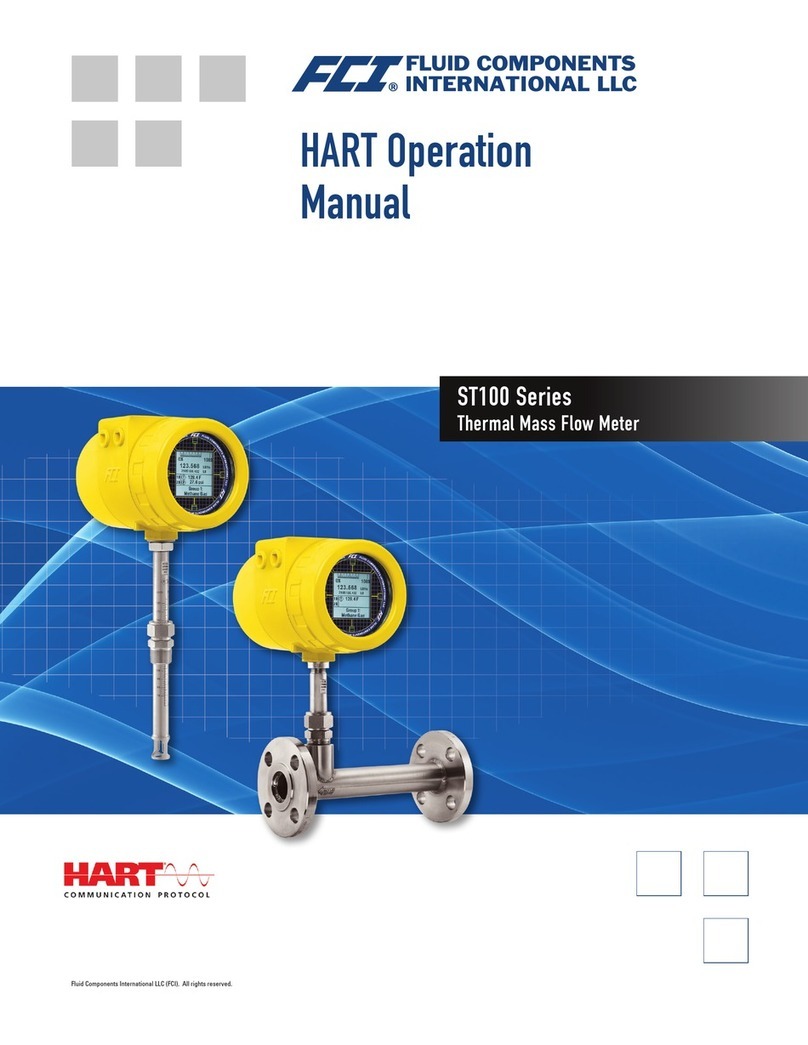
FCI
FCI ST100 series User manual
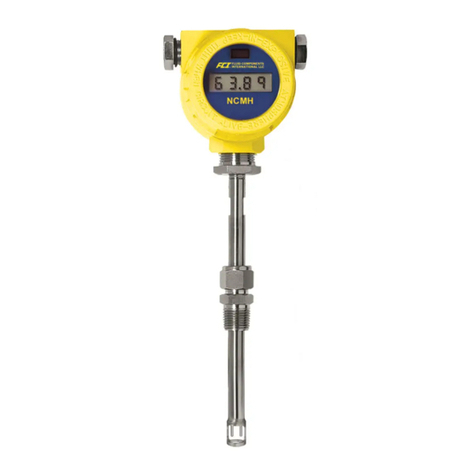
FCI
FCI ST50 Operating instructions

FCI
FCI ST100 series Mounting instructions
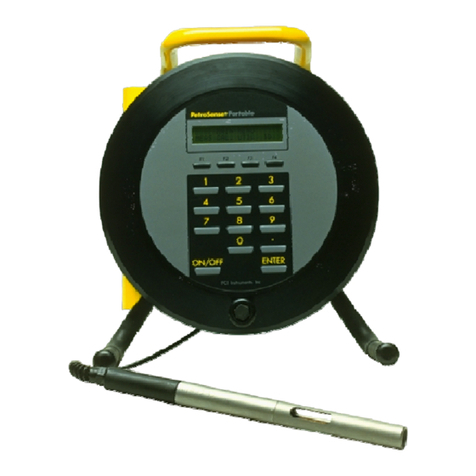
FCI
FCI PETROSENSE PHA-100Plus Setup guide

FCI
FCI ST100 series User manual
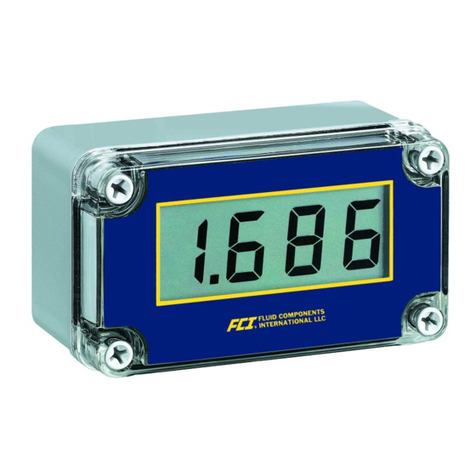
FCI
FCI DM10-FM User manual

FCI
FCI MT100 User manual
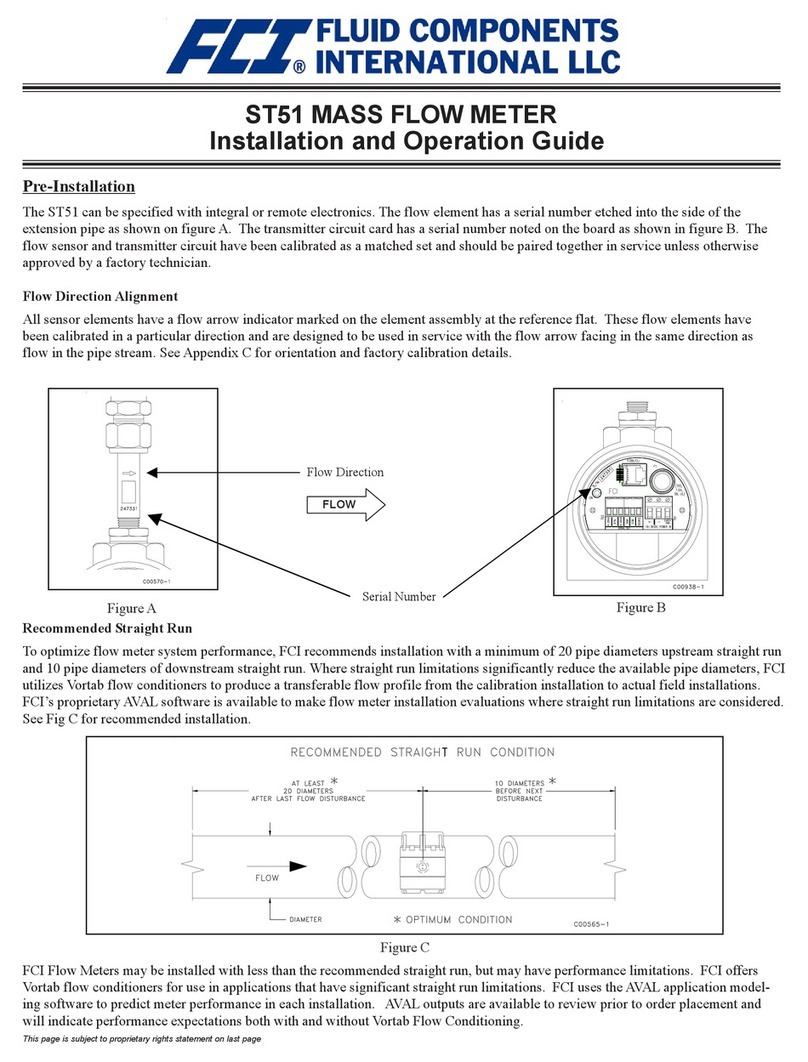
FCI
FCI ST51 Operating instructions

FCI
FCI ST50 User manual

FCI
FCI ST100 series Owner's manual
